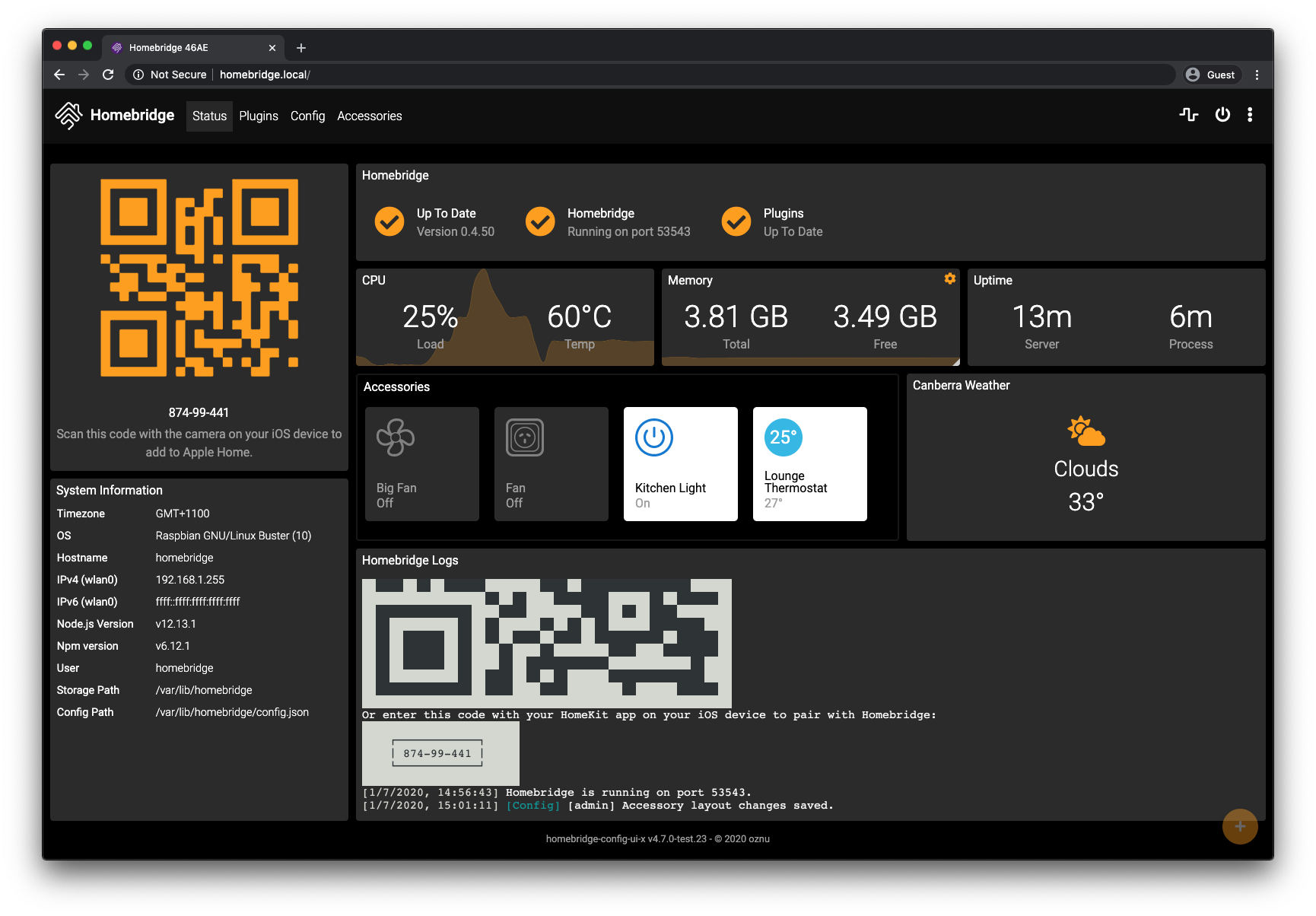Install Homebridge on Raspbian
This guide provides step-by-step instructions to show you how to install Homebridge on a Raspberry Pi as a service so it will automatically start on boot.
💡 The Official Homebridge Raspberry Pi Image is also available.
- Prerequisites
- Installing Homebridge
- Multiple Instances
- Updating
- How To Uninstall Homebridge
- Configuration Reference
Before you get started, make sure you have the following ready:
- A Raspberry Pi running Raspberry Pi OS, Ubuntu or other Debian based operating system.
- Access to the Terminal. This can be via a desktop Terminal app, or remotely via SSH. You will need the ability to copy and paste commands from this guide into the terminal.
Supported architectures:
- armhf (armv6 / armv7) - 32 bit
- aarch64 (arm64) - 64 bit
Add the Homebridge Repository GPG key:
curl -sSfL https://repo.homebridge.io/KEY.gpg | sudo gpg --dearmor | sudo tee /usr/share/keyrings/homebridge.gpg > /dev/nullAdd the Homebridge Repository to the system sources:
echo "deb [signed-by=/usr/share/keyrings/homebridge.gpg] https://repo.homebridge.io stable main" | sudo tee /etc/apt/sources.list.d/homebridge.list > /dev/nullUpdate repositories:
sudo apt-get update
Install Homebridge:
sudo apt-get install homebridge
The Homebridge UI web interface will allow you to install, remove and update plugins, and modify the Homebridge config.json and manage other aspects of your Homebridge service.
Login to the web interface by going to http://<ip address of your server>:8581.
To find the IP address of your server you can run:
hostname -I

Review the Configuration Reference at the bottom of this guide.
This installation method does not support multiple instances. Use Child Bridges instead.
You can update Homebridge and the bundled Node.js runtime by installing the latest version of the Homebridge package using apt.
Update repositories:
sudo apt-get update
Install latest version of the Homebridge package:
sudo apt-get install homebridge
You can also update the bundled Node.js runtime independently by running:
# don't use sudo if running from the Homebridge UI Terminal
sudo hb-service update-node To uninstall Homebridge run:
sudo apt-get remove homebridge
Optionally, remove the Homebridge repository:
sudo rm -rf /etc/apt/sources.list.d/homebridge.list
Optionally, to uninstall and remove all plugins and user config run:
# WARNING: This will delete /var/lib/homebridge, all your plugins, and Homebridge config.
sudo apt-get purge homebridgeThis table contains important information about your setup. You can use the information provided here as a reference when configuring or troubleshooting your environment after setting up Homebridge using the instructions below.
| File Location / Command | |
|---|---|
| Config File Path | /var/lib/homebridge/config.json |
| Storage Path | /var/lib/homebridge |
| Plugin Path | /var/lib/homebridge/node_modules |
| Node Path | /opt/homebridge/bin/node |
| Restart Command | sudo hb-service restart |
| Stop Command | sudo hb-service stop |
| Start Command | sudo hb-service start |
| View Logs Command | sudo hb-service logs |
| Install Plugin | sudo hb-service add homebridge-example |
| Remove Plugin | sudo hb-service remove homebridge-example |
| Enter Homebridge Shell | sudo hb-shell |
Click here for the configuration reference for setups done before May 2022
| File Location / Command | |
|---|---|
| Config File Path | /var/lib/homebridge/config.json |
| Storage Path | /var/lib/homebridge |
| Restart Command | sudo hb-service restart |
| Stop Command | sudo hb-service stop |
| Start Command | sudo hb-service start |
| View Logs Command | sudo hb-service logs |
| Systemd Service File | /etc/systemd/system/homebridge.service |
| Systemd Env File | /etc/default/homebridge |
Click here for the configuration reference for setups done before January 2020
| File Location / Command | |
|---|---|
| Config File Path | /var/lib/homebridge/config.json |
| Storage Path | /var/lib/homebridge |
| Restart Command | systemctl restart homebridge |
| Stop Command | systemctl stop homebridge |
| Start Command | systemctl start homebridge |
| View Logs Command | journalctl -f -n 100 -u homebridge |
| Systemd Service File | /etc/systemd/system/homebridge.service |
| Systemd Env File | /etc/default/homebridge |
- Raspberry Pi
- Debian, Ubuntu
- CentOS, Fedora, Red Hat
- Arch, Manjaro
- macOS
- Windows 10 / 11 (Hyper-V)
- Docker
- Synology DSM 7
- Other Platforms
- Basic Troubleshooting
- Backup and Restore
- Child Bridges
- Config File
- Connect To HomeKit
- FFmpeg for Homebridge
- HomeKit Glossary of Terms
- iOS Homemanager App
- mDNS Options
- Remote Access
- Useful Links
- Basic Troubleshooting
- Config Options
- Enabling Accessory Control
- Enabling UI with Docker
- Homebridge Service Command
- Manual Configuration
- Reverse Proxy: Apache
- Reverse Proxy: Nginx and SSL
- Standalone Mode
- Swap From Standalone To Service Mode
- Developer Docs
- API Reference
- Plugin Templates
- Other Links (Internal)
- Other Links (External)